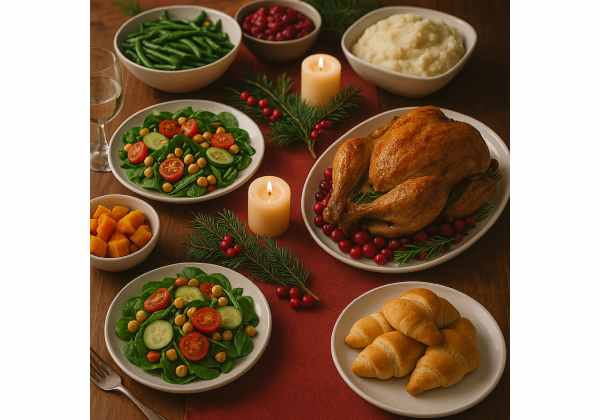
Holidays bring travel, late nights, and tables full of rich, nostalgic food. You do not need to diet through celebration. You do need a plan that protects momentum while leaving room for favourites. This guide turns crowded calendars into simple choices by focusing on plate design, meal timing, movement, alcohol, desserts, and social scripts. If you want a broader foundation for sustainable results—including sleep and stress skills that steady appetite—start with our practical habits-first framework, then use the strategies below to navigate parties, potlucks, and family dinners with confidence.
Table of Contents
- What is a holiday eating game plan?
- How to plan your holiday plate
- Strategic timing for meals and movement
- Alcohol, desserts and portion swaps
- Social scripts and boundaries
- Travel and hosting logistics
- Day-after reset protocol
- Frequently Asked Questions
What is a holiday eating game plan?
A holiday eating game plan is a short, repeatable set of decisions that lets you enjoy special meals without drifting for weeks. It does not ban foods or require calorie counting at the table. It shifts three things you control in any setting: how you build your plate, time meals and movement, and handle social pressure.
What this plan protects
- Momentum: You keep your weekday structure and adjust only a handful of meals.
- Energy: You avoid extremes—starving all day or overeating late—so mood and sleep stay steadier.
- Identity: You eat like a person with goals, not a person on a temporary diet.
Core principles
- Decide the day’s anchor. Pick one: a protein-forward breakfast, a balanced pre-event snack, or a 10-minute post-meal walk. One anchor beats a dozen rules.
- Front-load protein and plants. Aim for 25–35 g protein at the first meal and 2+ cups of vegetables at the main event.
- Choose your indulgence intentionally. Alcohol, sides, or dessert—enjoy one or two, not all three at full portions.
- Use environment and scripts, not willpower. Sit farther from the snack table. Serve yourself once. Practice two polite lines to deflect pressure.
What a good day looks like
- Morning: Protein-rich breakfast (eggs and fruit or yogurt and oats). Hydrate with 300–500 ml of water.
- Pre-event: A small snack with protein + fiber—Greek yogurt with berries, cottage cheese with tomatoes, or an apple with peanut butter.
- Event meal: Plate built with the ½ vegetables, ¼ protein, ¼ starch template, plus a favourite side or dessert mindfully portioned.
- After: A 10-minute walk with a friend, then herbal tea at home.
Why it works
- Protein and fiber blunt hunger, so you arrive steady instead of ravenous.
- Brief post-meal movement improves digestion and helps you stop grazing.
- Planned indulgence reduces all-or-nothing spirals.
If you are newer to healthy weight change, skim our concise safe weight loss basics so you understand the big picture. Then use the sections below to craft your personal playbook for parties, buffets, and family-style dinners. The goal is a holiday season you remember for the company and the moments—not for food regret.
How to plan your holiday plate
Great plates solve holiday eating before you take the first bite. Build with structure first, favourites second. The structure satisfies; favourites add joy.
The template
- ½ vegetables or fruit: roasted vegetables, salad, green beans, coleslaw, citrus salad. If produce is scarce, use the most fibrous options available (red cabbage, Brussels sprouts, root vegetables) or add a double portion of the leanest sides.
- ¼ protein (about a palm to a palm and a half): turkey, ham, roast beef, fish, tofu, tempeh, lentil loaf. Remove visibly thick skin or fat if you prefer a lighter plate.
- ¼ smart starch (about a cupped hand): potatoes, stuffing, rice, pilaf, bread, or pasta. If sauces are rich, start with ½ cup and add more only if you are still hungry.
Practical add-ons
- Flavor without drift: gravy by the tablespoon, cranberry sauce by the spoon, a pat of butter for potatoes. Measure with serving spoons, not the ladle.
- Protein boosters: a second palm of protein if desserts are non-negotiable; it steadies appetite and reduces picking later.
- Volume tricks: if the only vegetables are buttery, pile a large green salad first, then add smaller portions of richer sides.
Sample holiday plates
- Roast dinner: large salad with vinaigrette → palm of roast turkey → ½ cup stuffing → spoon of gravy → roasted carrots. If you want pie later, keep starch at ½ cup.
- Buffet or potluck: circle once without a plate. Choose two proteins, one starch you truly want, and two vegetables. Skip filler items you eat weekly.
- Cultural feast with shared dishes: serve once onto your plate. Choose one fried item you love and portion the rest from the template.
Second helpings rule
Wait 10 minutes after finishing. Drink water or tea. If still hungry, go back only for protein and vegetables. Save dessert for its own plate later.
Dessert planning within the plate strategy
If dessert is special, reduce starch at dinner to make room. Aim for half-size of a favourite or share. Serve on a small plate, sit, and eat slowly.
Using the plate method without counting
You can keep excellent control without numbers. For a refresher on portions and protein targets without calorie math, review our simple plate method approach before the season starts.
What to prep if you are contributing
Bring a high-volume vegetable that tastes great: lemony green beans, slaw with apples, or a big salad with nuts on the side. You give everyone—including you—an easy win.
Strategic timing for meals and movement
Holidays often compress meals and stretch evenings. Timing choices reduce overeating without rigid rules.
Anchor breakfast
Start with 25–35 g protein within a few hours of waking. Options: eggs and fruit, Greek yogurt with oats, tofu scramble with vegetables. Add 300–500 ml water. Protein early improves appetite control and steadies energy for travel or hosting.
Pre-event snack
Arriving hungry to a buffet is a guarantee you will over-serve. Ninety minutes before the event, eat a protein + fiber mini-meal:
- Greek yogurt with berries
- Cottage cheese with tomatoes
- Tuna pouch on rice cakes
- Apple with 1 tbsp peanut butter
Meal spacing
If the main meal is late, slot a small snack in the afternoon to prevent the 6 p.m. crash. Keep it 150–250 kcal with at least 10 g protein. If the meal is midday, plan a lighter supper with protein and vegetables.
Post-meal movement
Do a 10-minute walk after meals whenever possible. It aids digestion and nudges blood sugar in a steadier direction, which helps with energy and cravings later. For a step-by-step approach, see our practical guide to 10-minute walks.
Hydration rhythm
Alcohol and salty foods increase thirst and can mimic hunger. Use a simple cadence: water on waking, water before the event, water between plates, and water before bed. If you enjoy bubbles, choose sparkling water with citrus between drinks.
Caffeine timing
A midday coffee can be helpful for energy during travel days, but stop caffeine 6–8 hours before bedtime to protect sleep. Better sleep reduces late-night nibbling and supports recovery from rich meals.
Late-night grazing safeguard
After dishes are done, brew herbal tea and brush your teeth. Create a 10-minute pause before dessert or second dessert. If you still want it, plate a small portion and enjoy it seated.
Travel days
Airports and road trips are easiest with pre-packed protein (jerky, Greek yogurt if you have a cooler, roasted chickpeas, tuna pouches). Aim for one protein and one fiber at each stop. Avoid skipping all day and “making up for it” at 9 p.m.—it backfires.
What to expect with timing done well
- You eat once at the event, not continuously for six hours.
- You wake up less bloated and more rested.
- You return to routine the next day without starting over.
Alcohol, desserts and portion swaps
Celebrations often include drinks and sweets. Include them on purpose rather than by drift.
Alcohol game plan
- Decide a cap in advance. Many people feel best with 0–2 drinks at an event. Set your number before arriving.
- Alternate with water. One drink, one water. This slows pace and reduces mindless refills.
- Choose lighter options: dry wine, spirits with soda water and citrus, or a spritzer. Avoid heavy mixers and keep craft cocktails to one.
- Pour sizes matter. A “standard drink” is smaller than most home pours. Use smaller glasses when hosting.
For more detail and specific drink choices, see practical lower-calorie choices in our quick guide to alcohol habits.
Dessert strategy
- Pick the standouts. Choose the dessert you look forward to all year; skip the average plate fillers.
- Use the half-and-savor rule. Take half the usual slice. Sit, slow down, and notice the first six bites.
- Share or split. Dessert tastes are social; splitting gives you variety without doubling portions.
- Separate plates. Do not stack dessert onto the dinner plate; a fresh plate creates a pause and prevents automatic seconds.
Portion swaps that save you without feeling “light”
- Stuffing and potatoes: take ½ cup of one rich starch and add extra vegetables rather than full scoops of both.
- Cheese and crackers: choose 3–4 wedges of your favourite cheese and pair with sliced fruit and nuts instead of a pile of crackers.
- Gravy and sauces: spoon over protein only, not the whole plate.
- Charcuterie boards: make a mini plate with one protein, one cheese, one bread/cracker, and two fruits or vegetables. Eat it away from the board.
When alcohol or dessert pressure shows up
Keep two polite scripts ready: “That looks amazing—I am full right now,” or “I am starting with this and coming back if I have room.” Delivered with a smile, they work in most rooms.
Social scripts and boundaries
Food is culture, love, and sometimes pressure. Scripts protect relationships and your plan at the same time.
Polite declines that keep connections warm
- “Everything looks great. I am going to start with this and check in later.”
- “I promised myself one dessert tonight. Saving space for it.”
- “I am good for now—could I take some home?” (Bring small containers if you are close to the host.)
When someone insists
- Reflect and redirect: “It smells amazing; you must have put a lot of work into it. Can I get the recipe to make it next week?”
- Boundary with appreciation: “Thank you, I am comfortable. I would love coffee or tea, though.”
If comments become personal
- “I am focusing on feeling good through the season. Thanks for understanding.”
- Change the subject: ask about travel, kids, or a shared interest.
Host strategies that help everyone
- Offer small plates for desserts and appetizers.
- Place snacks away from seating areas to reduce mindless munching.
- Keep a pitcher of water with citrus beside the wine.
Bring your wins
- Arrive with a big salad, a vegetable side, or fruit for dessert. You contribute and create a guaranteed option for yourself.
- If you are traveling, bring an easy protein + fiber snack so you can decline politely without hunger.
Lean on people who get it
Tell one ally your plan on the way in—“I am doing one plate and one dessert tonight.” A friend or partner can provide subtle support or a timely change of topic. For more ideas on helpful allies, see building a simple support system.
Mindset to carry
You are not anti-dessert; you are pro-intention. You are not anti-family; you are pro-boundaries. The holiday is long. You can enjoy without turning every hour into a feast.
Travel and hosting logistics
Logistics decide more than willpower. A little prep reduces chaos and makes good choices easier.
Travel kit
- Protein: tuna pouches, jerky or baked tofu, Greek yogurt if you have a cooler, shelf-stable shakes.
- Fiber: apples, pears, baby carrots, roasted chickpeas.
- Tools: foldable water bottle, tea bags, plastic cutlery, a small container of nuts.
- Back-up meal: microwave rice cup + beans + salsa; most convenience stores have versions of these.
Airport and road tips
- Eat a protein-forward meal before you leave or carry a solid snack.
- At airports, look for a salad with grilled protein or a burrito bowl with beans and vegetables.
- For road trips, stop at supermarkets instead of fast food when possible; rotisserie chicken and pre-washed salad save the day.
Hotel plan
- On check-in, identify the closest supermarket. Pick up breakfast (yogurt, fruit, oats) and water.
- Use the hotel gym for 10–15 minute movement breaks or stairwells for quick climbs.
- Keep one dessert in the room only if you intend to eat it; otherwise, rely on lobby coffee or tea.
Hosting without stress
- Menu structure: one protein, two vegetable sides, one starch, one bread, two desserts. Variety without explosion.
- Plating: serve mains family-style but keep desserts in the kitchen with small plates.
- Leftovers: send dessert home in small containers; keep protein and vegetables for your next day.
Table layout that subtly helps
- Place salad and vegetables closest to you.
- Put water on the table and wine on a sideboard.
- Use smaller dessert plates and normal dinner forks for sweets.
Travel days are tiring; hosting days are busy. That is normal. A travel routine that includes pre-packed snacks, short walks, and a simple breakfast template keeps you steady. See our step-by-step travel routine for more details you can copy.
Day-after reset protocol
The day after a big meal is where many people either return to routine or slide into a week of leftovers and takeout. Use a light, specific protocol that resets you without punishment.
Morning
- Drink 300–500 ml of water on waking.
- Eat a protein-forward breakfast with fruit (yogurt bowl, eggs and berries, tofu scramble).
- Take a 10–20 minute walk outside to shake off sluggishness.
Midday
- Build a simple plate: ½ vegetables, ¼ protein, ¼ starch. Soup and salad with chicken or beans works well.
- Keep snacks to protein + fiber only: cottage cheese with tomatoes, tuna on crackers, or fruit with a tablespoon of nut butter.
Evening
- Make dinner boring and steady: sheet-pan protein and vegetables or a stir-fry with rice.
- Brew herbal tea after dishes and brush teeth to mark the kitchen closed.
Mindset and measurement
- Expect water weight from salt and higher carbs. It resolves in a day or two with normal eating and hydration.
- If you weigh yourself, look at the trend across weeks, not one day. A single salty meal can add 1–2 kg of temporary weight via water shifts.
Leftovers triage
- Keep lean proteins and vegetables for lunches.
- Freezer or gift away extra desserts beyond what you plan to eat this week.
- Create pre-portioned containers if you want to enjoy sides across several days.
When you overshoot
If yesterday went far off plan, do not under-eat today. Eat normally, walk, hydrate, and resume your routine. The fastest way back is through consistent basics, not extremes.
Plan for the next event
Note what helped most: a pre-event snack, a 10-minute walk, a firm dessert plan, or a social script. Use that one lever intentionally next time.
Frequently Asked Questions
What should I eat before a holiday party?
Have a protein + fiber mini-meal 60–90 minutes before the event—Greek yogurt with berries, cottage cheese with tomatoes, or tuna on rice cakes. You will arrive steady, serve yourself once, and enjoy favourites without raiding the appetizer table.
How many drinks can I have and still make progress?
Decide a cap before the event—often 0–2 drinks feels best for energy, sleep, and appetite. Alternate each drink with water, choose lighter options like dry wine or spirits with soda, and stop caffeine six hours before bed to protect sleep.
Do I need to skip dessert to stay on track?
No. Choose the dessert you look forward to all year, serve half the usual portion, and eat it seated and slowly. Trade down a starch at dinner if needed. If you want variety, split two small desserts instead of one large slice.
How do I handle relatives who push food?
Use polite lines and redirect: “Everything looks great—starting with this,” or “I promised myself one dessert.” Compliment the dish, ask for the recipe, or take a small portion to-go. You protect relationships and your plan at the same time.
Are post-meal walks really helpful?
Yes. A 10-minute walk after meals supports digestion and steadier energy later in the evening. It is short, social, and easy to repeat during travel or family gatherings. If weather is bad, climb stairs or walk indoor hallways for the same effect.
What if I overeat at one meal?
Reset the next morning: hydrate, eat a protein-forward breakfast, and take a short walk. Expect temporary water weight from salt and carbs. Do not under-eat or “work it off.” Return to normal plates and sleep; progress resumes with routine.
References
- After Dinner Rest a While, After Supper Walk a Mile? A Systematic Review with Meta-analysis on the Acute Postprandial Glycemic Response to Exercise Before and After Meal Ingestion in Healthy Subjects and Patients with Impaired Glucose Tolerance – PMC 2023 (Systematic Review)
- The Acute Effects of Interrupting Prolonged Sitting Time in Adults with Standing and Light-Intensity Walking on Biomarkers of Cardiometabolic Health in Adults: A Systematic Review and Meta-analysis – PMC 2022 (Systematic Review)
- A dairy-based, protein-rich breakfast enhances satiety and cognitive concentration before lunch in overweight to obese young females: A randomized controlled crossover study – PubMed 2024 (RCT)
- Diabetes Meal Planning | Diabetes | CDC 2024 (Guideline)
- What Is A Standard Drink? | National Institute on Alcohol Abuse and Alcoholism (NIAAA) 2024 (Guideline)
Disclaimer
This guide provides general nutrition and behavior information for healthy adults. It does not replace individualized medical advice. If you have medical conditions, food allergies, take prescription medications, are pregnant, or have an eating disorder history, consult a qualified healthcare professional before changing your diet, alcohol intake, or activity.
Share and follow
If this game plan helps you enjoy the season without losing momentum, consider sharing it with a friend or family member. You are also welcome to follow us on Facebook, X, or any social network you use for steady, practical updates on habits, sleep, stress, and nutrition.










